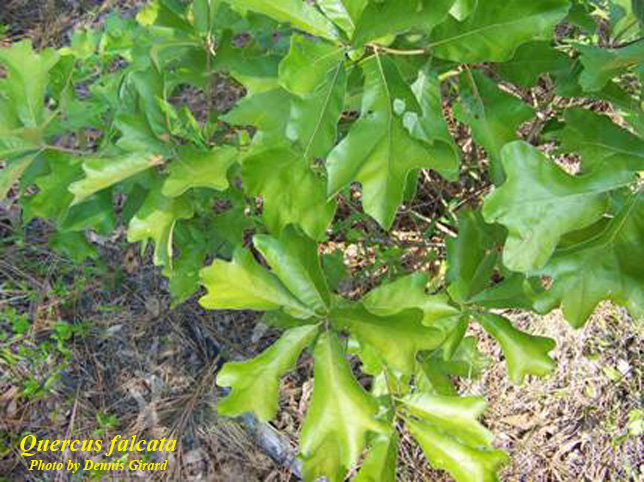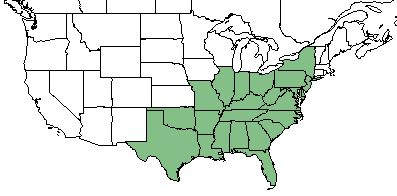Quercus falcata
Common name: Spanish oak [1], southern red oak [1]
| Quercus falcata | |
|---|---|

| |
| Photo by Dennis Girard hosted at Atlas of Florida Plants | |
| Scientific classification | |
| Kingdom: | Plantae |
| Division: | Magnoliophyta - Flowering plants |
| Class: | Magnoliopsida - Dicots |
| Order: | Fagales |
| Family: | Fagaceae |
| Genus: | Quercus |
| Species: | Q. falcata |
| Binomial name | |
| Quercus falcata Michx. | |

| |
| Natural range of Quercus falcata from USDA NRCS Plants Database | |
Contents
Taxonomic Notes
Synonyms: Q. digitata Sudworth; Q. triloba Michaux
Varieties: Quercus falcata var. falcata; Q. falcata var. triloba (Michaux) Nuttall
Description
Q. falcata is a perennial tree of the Fagaceae family native to North America.[2]
Distribution
Q. falcata is found in the southeastern corner of the United States from Texas to New York.[2]
Ecology
Habitat
Q. falcata proliferates in upland forests, usually xeric or submesic, but occasionally in mesic situations.[1] Specimens have been collected from dry sandy soil, pasture, second growth upland mixed woodland, mixed hardwood, open pine-oak-hickorym dry sandy loam, upland old field, and near edge of bluff.[3]
Q. falcata does not respond to soil disturbance by clearcutting and chopping in north Florida flatwoods forests.[4]
This species has mixed responses to soil disturbance by roller chopping and disturbance by a KG blade in east Texas Loblolly Pine-Hardwood Forests. It has shown variable changes in frequency to each disturbance type.[5]
Quercus falcata is frequent and abundant in the North Florida Longleaf Woodlands and Panhandle Silty Longleaf Woodlands community type. It is an indicator species for the Clayhill Longleaf Woodlands community type as described in Carr et al. (2010).[6]
Phenology
Q. falcata has been observed to flower in March, April, and October.[7]
Seed dispersal
This species is thought to be dispersed by gravity.[8]
Fire ecology
Q. falcata is not fire resistant and has low fire tolerance[2]; despite this, populations of Quercus falcata have been known to persist through repeated annual burns.[9][10]
Herbivory and toxicology
Quercus falcata has been observed to host froghoppers such as Lepyronia quadrangularis (family Cercopidae), leafhoppers from the Cicadellidae family such as Alebra aurea, Eratoneura acantha, Graphocephala coccinea, Idiocerus sp. and Scaphytopius sp., true bugs such as Cedusa sp. (family Derbidae), planthoppers such as Flatormenis proxima (family Flatidae), and treehoppers from the Membracidae family such as Atymna querci, Cyrtolobus funkhouseri, Cyrtolobus maculifrontis, Cyrtolobus ovatus, Cyrtolobus tuberosus, Glossonotus acuminatus, Glossonotus univittatus, Ophiderma definita, Ophiderma pubescens, Ophiderma salamandra, Smilia camelus, Spissistilus festinus, Telamona decorata, and Telamona monticola.[11]
Conservation, cultivation, and restoration
Q. falcata is listed as threatened by the Ohio Department of Natural Resources Division of Natural Areas and Preserves, and as endangered by the Pennsylvania Department of Conservation and Natural Resources.[2]
Cultural use
Acorns were an important staple for Native Americans in making flour for breads. The meat could also be edible once the tannins were leached from the acorns.[12]
The fruit of this particular species has a sweet juice that can be consumed.[13]
Photo Gallery
References and notes
- ↑ 1.0 1.1 1.2 Weakley, A. S. (2015). Flora of the Southern and Mid-Atlantic States. Chapel Hill, NC, University of North Carolina Herbarium.
- ↑ 2.0 2.1 2.2 2.3 USDA Plant Database https://plants.usda.gov/core/profile?symbol=QUFA
- ↑ URL: http://herbarium.bio.fsu.edu. Last accessed: June 2018. Collectors: Loran Anderson, Cecil Slaughter, R.K. Godfrey, W.D. Reese, H. Kurz, Kathy Craddock Burks, Patricia Elliot, R.F. Doren, Richard Mitchell, Celeste Baylor, Karen MacClendon, Daniel B. Ward, S.J. Ward, Kevin Oakes, Chris Cooksey, Palmer Kinser, Bob Farley. States and counties: Florida (Franklin, Marion, Jackson, Alachua, Leon, Wakulla, Washington, Okaloosa, Columbia, Liberty, Jefferson, Calhoun, Holmes, Nassau) South Carolina (Berkeley) Georgia (Brooks, Grady, Thomas) Alabama (Morgan)
- ↑ Moore, W.H., B.F. Swindel, and W.S. Terry. (1982). Vegetative Response to Clearcutting and Chopping in a North Florida Flatwoods Forest. Journal of Range Management 35(2):214-218.
- ↑ Stransky, J.J., J.C. Huntley, and Wanda J. Risner. (1986). Net Community Production Dynamics in the Herb-Shrub Stratum of a Loblolly Pine-Hardwood Forest: Effects of CLearcutting and Site Preparation. Gen. Tech. Rep. SO-61. New Orleans, LA: U.S. Dept of Agriculture, Forest Service, Southern Forest Experiment Station. 11 p.
- ↑ Carr, S.C., K.M. Robertson, and R.K. Peet. 2010. A vegetation classification of fire-dependent pinelands of Florida. Castanea 75:153-189.
- ↑ Nelson, G. PanFlora: Plant data for the eastern United States with emphasis on the Southeastern Coastal Plains, Florida, and the Florida Panhandle. www.gilnelson.com/PanFlora/ Accessed: 24 MAY 2018
- ↑ Kirkman, L. Katherine. Unpublished database of seed dispersal mode of plants found in Coastal Plain longleaf pine-grasslands of the Jones Ecological Research Center, Georgia.
- ↑ Robertson, K.M. Unpublished data collected from Pebble Hill Fire Plots, Pebble Hill Plantation, Thomasville, Georgia.
- ↑ Platt, W.J., R. Carter, G. Nelson, W. Baker, S. Hermann, J. Kane, L. Anderson, M. Smith, K. Robertson. 2021. Unpublished species list of Wade Tract old-growth longleaf pine savanna, Thomasville, Georgia.
- ↑ Discoverlife.org [1]
- ↑ Fernald, et al. 1958. Edible Plants of Eastern North America. Harper and Row Publishers, New York.
- ↑ Fernald, et al. 1958. Edible Plants of Eastern North America. Harper and Row Publishers, New York.